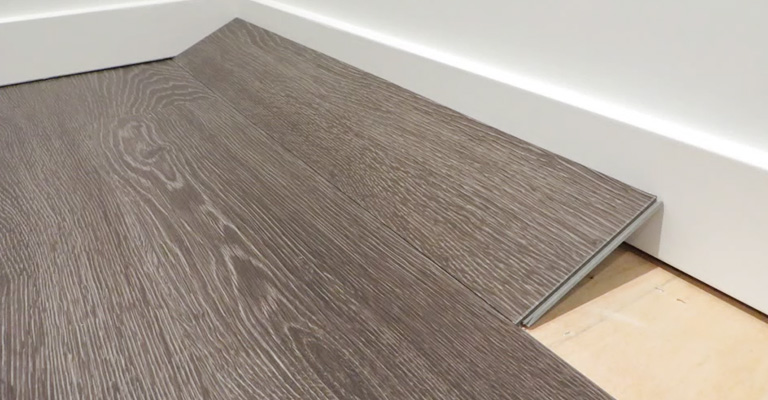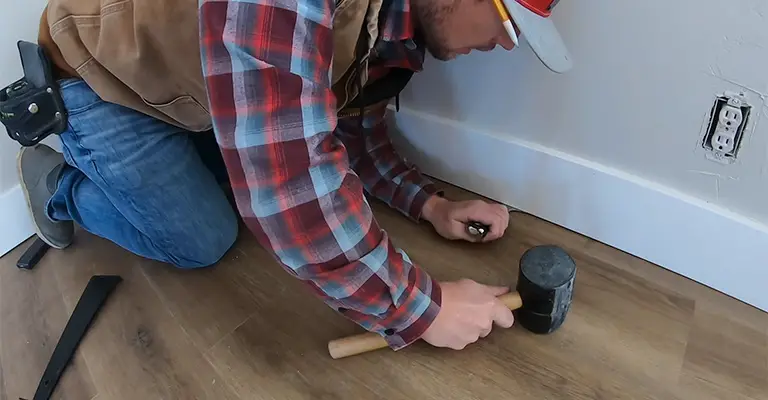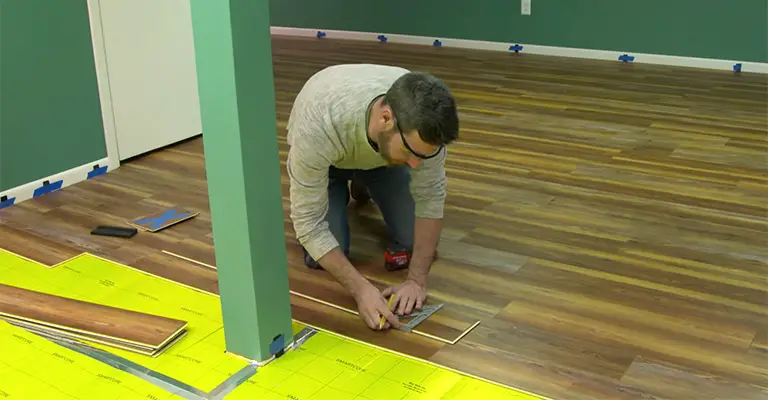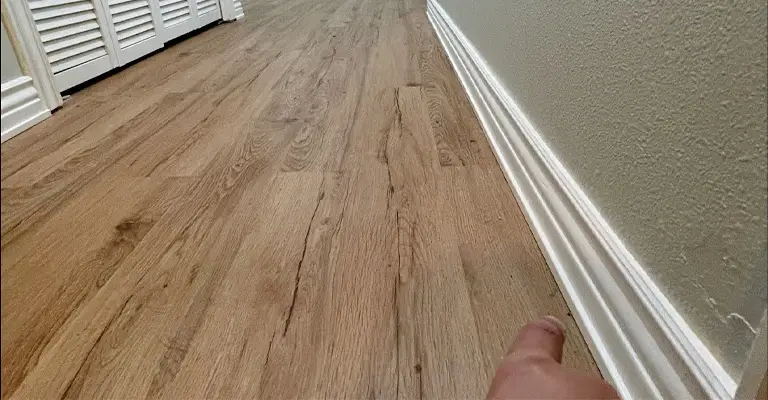When transforming your space’s look and feel, vinyl flooring offers an attractive and durable option.
Whether you’re updating a single room or revamping your entire home, one common question arises: “Do you have to remove baseboards to install vinyl flooring?”
When installing vinyl flooring, you will need to remove the baseboards. As far as the process is concerned, it is relatively straightforward.
To get the right amount of vinyl for the area, you must measure it and ensure that there is enough vinyl to cover it. Don’t want to remove the baseboards?
It’s okay to leave them in place, but you’ll need to leave a 1/4″ gap between the baseboard and flooring to allow room for expansion.
If you want to cover up this gap, buy some quarter-round pieces in a matching color.
Additionally, you need to ensure that the space is level, which you can accomplish with a leveler or drywall. The vinyl can be installed after the floor is leveled.
As a first step, adhere the vinyl to the floor and apply the adhesive. Afterward, you will need to cut the vinyl to fit the space and adhere it to the floor. In the end, vinyl excess needs to be trimmed off.
To make installation easier, consider removing trim that makes contact with the floor. This should include baseboards, shoe moldings, and case moldings around doors if possible.
Remove the trim after the floor is installed and set it aside for installation afterward if it is still a good condition. Carpet fitted into baseboards or skirting is the only flooring you can install without removing them.
Can You Install Flooring Without Removing Baseboards?

You’re in luck if you want to install hardwood floors without removing the baseboards. Other types of flooring can be installed in the same way.
You may want to leave your baseboards in place if they are glued to the wall and are likely to cause damage if removed.
Additionally, you may have a short timeline, meaning you won’t have time to remove the baseboards, which is perfectly fine.
Cover the expansion gap left by the baseboards with quarter-round molding for hardwood installations.
Don’t Want To Deal With Removing Baseboards?

The baseboards can stay in place, but you’ll need to leave a 1/4″ gap between them and the flooring so that the floor doesn’t expand too drastically.
To cover up this gap, you may need to purchase some quarter-round pieces in a coordinating color. However, we recommend removing the baseboards before laying down new flooring for a better appearance.
More On Installing Floorings Without Removing Baseboards
I’ve said before that fitted carpet is the only flooring you can install appropriately without removing baseboards/skirting.
If you want to install other flooring such as tile, sheet vinyl, LVP, hardwood and laminate without removing the baseboards, apply a quarter round over the exposed ends.
However, the result looks amateurish and is typical of cheap work. I immediately turn away when I see that. It makes me want to rip out the whole floor and redo it properly, which lowers my perception of the house’s value.
That isn’t an unusual opinion. Take out the baseboards every time. You will save time and produce a better and more professional-looking result. Before reinstalling them, freshen up the paint on them.
A paint edge needs to be sanded down if the new flooring is lower than what you are taking out (most often laminate and luxury vinyl plank).
Afterward, repair any shortcomings and repaint the bottoms of the walls (if you have some fresh paint; otherwise, repaint the entire room).
As hardwood flooring and tile (properly installed with backer board) usually rise higher than the old flooring, the baseboards will have to be moved up, so less work has to be done, and barely any touch-up is required.
You can gently pry off the baseboard/skirting by running a knife along the top where the paint joins the wall.
Unless the seam is cut through, you will tear paint and more from the wall when you remove the board, but if it is cut through, it should peel cleanly away.
The old baseboards may be tempted to be replaced with something taller to cover up the damage. I agree that replacing natural wood with MDF might be a good idea, but don’t replace natural wood with particle board.
You can remove real wood, clean it, and reapply it multiple times. In addition to being a one-time-use product, MDF will usually tear and break once removed, so you will be forced to purchase it again in the future.
Removing nails from the baseboard by pulling them through from the back is more effective than knocking them out by the front. There is less repair to do before reinstalling the finishing nails because small nails will not damage the paint finish.
Things You Usually Do Before Installing Vinyl Plank Flooring

Installing vinyl plank flooring can be fairly easy, and it is an excellent way to upgrade any homeroom.
With a few tools, you can quickly transform any room in your house and give your tired floor a facelift in just a few days. As a preface:
Remove Existing Flooring
Currently, vinyl plank flooring is typically available as either glued down or floating floors. Floors installed with glue down may need to be removed from the subfloor and leveled before they can be laid.
Vinyl plank flooring, however, can generally be installed over your existing hard floor, saving you from tearing up the old floor.
You may need to remove the old flooring in bad condition for a proper installation of your new flooring. You can cover your old floor with underlayment if removing it is too difficult/dangerous.
Ensure to cut the door jams and provide enough clearance for appliances and cabinets before raising the floor.
Check Subfloor
It is essential to ensure the subfloor is solid, flat, and debris-free before removing the old flooring.
Fix any holes or cracks in your floors. You can also use a leveler to help with worn or damaged floors. It may be necessary to replace the subfloor if it is in poor condition. For subfloor recommendations, consult manufacturer guidelines.
Acclimate?
It is usually unnecessary for vinyl plank flooring to acclimate before installation. For more details, please consult your product.
When Should You Remove Baseboards?

Typically, baseboards are installed along the floors and walls closest to the floor. A baseboard conceals the joints between the wall and floor, enhancing visual appeal.
The majority of flooring applications do not require the removal of existing baseboards.
For example, you may wish to change the baseboard height or style to fit the overall look of your remodel by removing the baseboards and replacing them when you install new flooring.
When installing hardwood floors, you may want to detach the baseboards. It is possible to perform the following tasks after removing and reinstalling the baseboards:
- Covering the half-inch gap, ensure hardwood does not stick out along the walls.
- Afterward, you can repaint or buy new baseboards or replace the existing ones.
- Make sure your baseboards are appropriately positioned, considering the new floor height.
Tips for Removing Baseboards
A professional can provide advice or complete the task for you if removing your baseboards for new flooring is the best solution for your project. Follow these tips to make the process easier if you’re doing it alone:
- You should remove the baseboards the day before installation to move furniture away from the walls.
- To make matchups a snap, number the walls and the corresponding sections of the baseboards.
- Slicing any caulk that seals the baseboard to the wall can be done with a utility knife.
- If you want to prevent damage to your walls, place a piece of scrap wood behind the pry bar.
- To remove all the baseboards at once and avoid damaging them, pry the length while avoiding breaking the baseboards.
Final Words
You may be able to leave the baseboards in place as you install vinyl plank flooring that isn’t glued down and cover the gap from the baseboards to the new flooring with quarter-round molding.
It may be necessary to remove the baseboards before installing new flooring if your baseboards are damaged or not level or if you are installing adhesive-down vinyl flooring.
You should always consult the manufacturer’s instructions for specific installation instructions for your particular flooring product.







